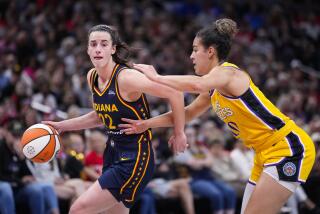‘Board Walk
- Share via
PARK CITY, Utah — She came in with a reputation for ferocious workouts, a go-for-it attitude and, occasionally, spectacular falls.
Now Kelly Clark is known for something else: As the United States’ first gold medal winner of the Salt Lake City Winter Olympic Games.
Clark, an 18-year-old from Mount Snow, Vermont, shook off the ill effects of a recent training spill to record a score of 47.9--including a perfect 10 for standard maneuvers--and win the women’s snowboarding halfpipe Sunday before a sun-soaked capacity crowd of 16,500 at Park City Mountain Resort.
“It means a lot to me and all the rest of the Americans here or anywhere,” said Clark, who trained for the Games at Mammoth Mountain. Then, referring to the national mood in the wake of the Sept. 11 terrorist attacks, she added, “We’ve had a tough couple of months here and it’s great to be part of something we can all take pride in.”
France’s Doriane Vidal, with a score of 43.0, took silver. Switzerland’s Fabienne Reuteler, at 39.7, won the bronze. Americans Shannon Dunn and Tricia Byrnes were fifth and sixth, respectively. Clark’s medal is the first gold for the U.S. in Olympic halfpipe competition. Dunn won bronze in Nagano four years ago.
On a sunny, warm day, under a brilliant blue sky, the crowd cheered for all 23 competitors, but loudest for the Americans. And as Clark’s final-run score was posted, fans erupted in a blizzard of red, white and blue flags and a roar that echoed around the mountains. Clark climbed over a retaining fence to celebrate with friends.
A short time earlier, Clark, the final competitor of the day, smiled and waved from the top of the run when her name was announced. Before the run, she was in second place, but the security of a silver medal just made her all the more aggressive.
“I figured I had second place wrapped up, so I had to go for it,” she said. “I knew I would regret it if I didn’t.”
So she threw herself into the course--a channel slightly longer than a football field with sidewalls about 12 feet high.
Performing to the Guns N’ Roses song “Welcome to the Jungle,” on the way down she did a 720--two complete spins--and a McTwist, an inverted 540-degree spin, floating high above the lip of the pipe. About halfway down, as she was extended horizontally about six feet over the lip, for an instant her body and board silhouetted against the sun.
At the bottom, she skidded to a stop, slipped her feet off her board and ran to her coach, Heath Van Aken, for extended hugs.
Only three days before, she was on her back motionless for 20 minutes--thinking “Oh, man, what bad timing for this”--after hitting the lip of the wall and crashing hard during a training run.
On Sunday, she was still sore, but also typically fearless.
“You really have to let go of the fear factor,” she said. “Once you break through that level of fear and feel comfortable with yourself, you can really push farther.”
Clark came into these Games on a roll. She had won a number of events in January and was “feeling pretty confident.”
“It’s nice knowing I could land my tricks,” she said.
On her first run Sunday, she scored 42.1--easily the top qualifying mark of the day.
But at the end, it was France’s Vidal, with a high-flying performance on the first of her two final runs, who seemed poised to win.
Just before her final run, Clark said the roar of the crowd was so loud it drowned out the Blink 182 song “This is Growing Up” she had blaring (“It gets me going,” she said) on her headphones.
Normally, she uses the music to cover distractions, but on Sunday that wasn’t possible. “I could hear them over the headphones,” she said of the appreciative fans.
In the halfpipe, the best athletes fly six or seven feet over the lip of the wall while executing acrobatic routines worthy of a first-rate gymnast. In the Olympics, judges place a premium on height because, as Vidal explained, “It’s better for the show”--meaning the spectators and television viewers.
However, many of the competitors still seemed more interested in complex aerobatic twists and turns, moves that in other competitions are more favorably rewarded.
The more acrobatic the run is, Byrnes said after qualifying for the finals, “that’s what the snowboarders are going to respect. If the judges don’t respond to it, at least [among your peers] you go out a champ.”
At the Olympics, however, she said, “All I know is you gotta go big.”
Clark did that--and more--on her final run. “She was going so high,” Vidal said.
The crowd was the biggest the snowboarders had ever performed in front of and they gave a performance that might have silenced critics--in and out of the sport--who wondered if snowboarding belonged in the Games. It was added to the competition in 1998.
“Snowboarders have their reputations,” Clark said. “But my doing this, especially in the U.S., says a lot. Maybe it will shine a light on snowboarding, and people will look at it in a different way.”
More to Read
Go beyond the scoreboard
Get the latest on L.A.'s teams in the daily Sports Report newsletter.
You may occasionally receive promotional content from the Los Angeles Times.






